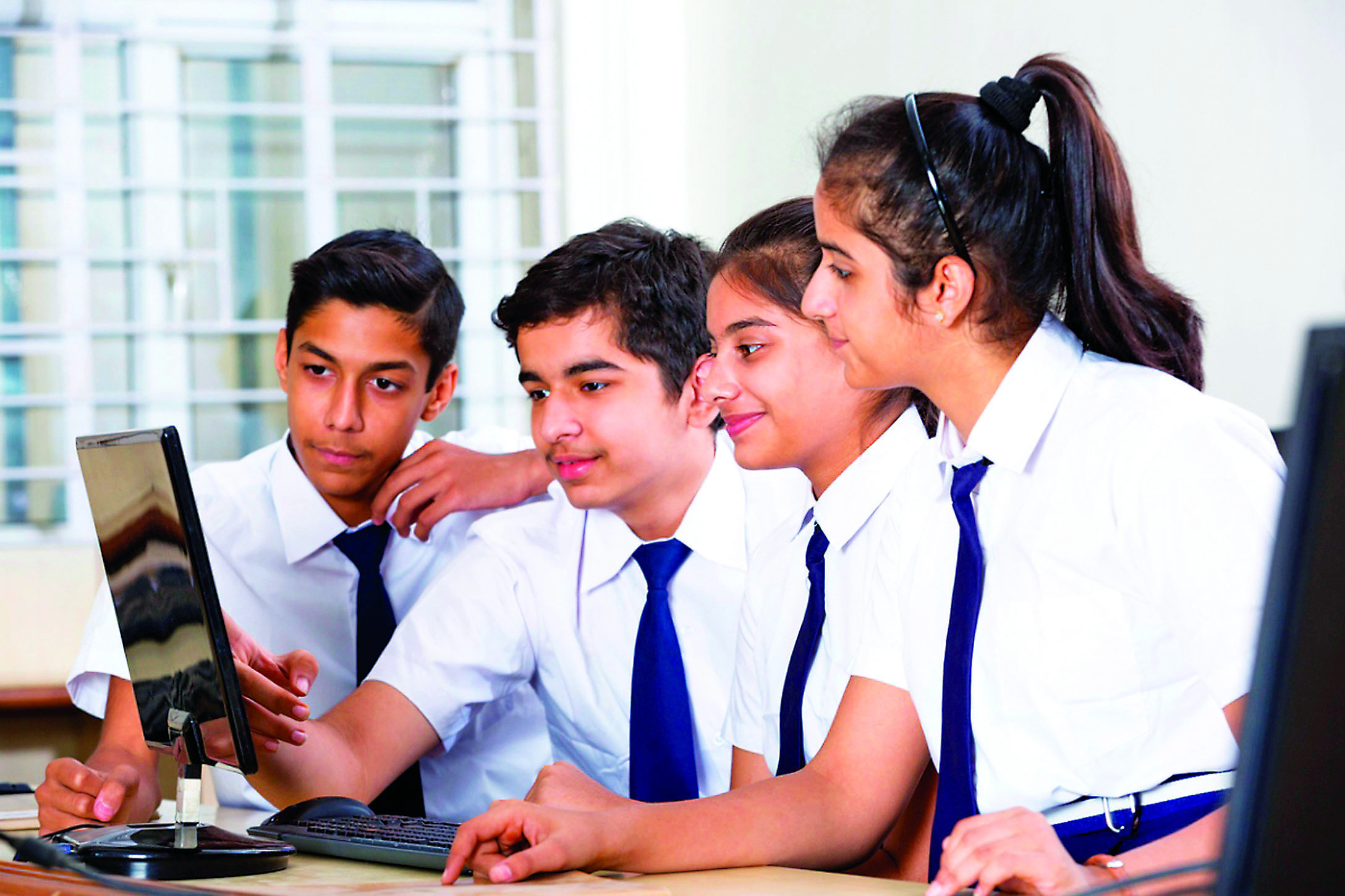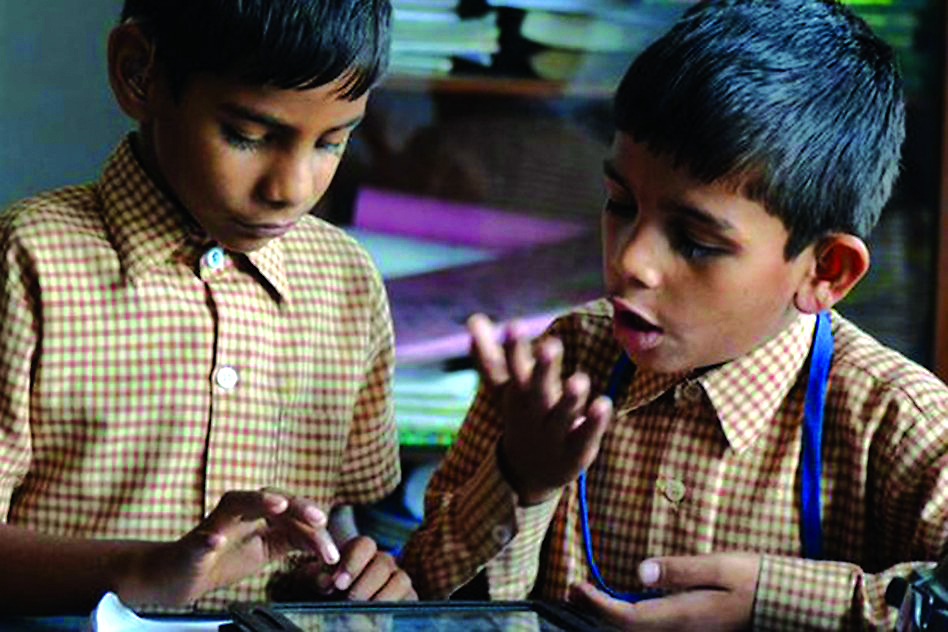 It is only on February 27, 2020, that NITI Aayog joined hands with NASSCOM to roll out artificial intelligence modules in Indian schools. Mind it 2019-2020 academic session is almost over now when the NITI Aayog and NASSCOM have joined hands to roll out the AI in schools. A statement issued after the event said that with an imperative to empower the youngest minds of the country with the latest technologies, NITI Aayog, Atal Innovation Mission (AIM) in collaboration with the National Association of Software and Services Companies (NASSCOM) on February 27 launched an AI-based Module rolled out for students in Indian schools.
It is only on February 27, 2020, that NITI Aayog joined hands with NASSCOM to roll out artificial intelligence modules in Indian schools. Mind it 2019-2020 academic session is almost over now when the NITI Aayog and NASSCOM have joined hands to roll out the AI in schools. A statement issued after the event said that with an imperative to empower the youngest minds of the country with the latest technologies, NITI Aayog, Atal Innovation Mission (AIM) in collaboration with the National Association of Software and Services Companies (NASSCOM) on February 27 launched an AI-based Module rolled out for students in Indian schools.
The AI-Base Module has been introduced with an objective for students to leverage the full potential of AIM’s Atal Tinkering Lab (ATL) and further empowers them to innovate and create valuable solutions benefiting societies at large. The module contains activities, videos and experiments that enable students to work through and learn the various concepts of AI.
Sharing his thoughts, CEO, NITI Aayog Amitabh Kant says that India could add 1.3 per cent to its GDP on an annual basis through the use of machine learning and artificial intelligence. “Indians can find solutions to the challenges of a shared connected zero-emission world, improving learning outcomes, disease like tuberculosis, cancer, etc. If we are able to find solutions to these challenges for the 1.3 billion people of India, we can find solutions for the 7.5 billion people of the world too,” he says. The AI module is so critical, in the sense that it will start teaching young children from a very young age then Indians will become major players in AI, as it has been done in the past for robots, 3D printing, IoT. “This is path-breaking, it combines playing and academics and our job is to make things very interesting. We want to make artificial intelligence a great fun so that children can enjoy it, they can evolve and learn and take India forward.”
CBSE for ‘AI ready’ next gen
 Significantly, the CBSE had issued a Circular No 14/ 2019-dated 09-03-2019 and had clearly communicated that: “Artificial Intelligence (AI) is being widely recognized to be the power that will fuel the future global digital economy. AI in the past few years has gained geo-strategic importance and a large number of countries are striving hard to stay ahead with their policy initiatives to get their country ready.
Significantly, the CBSE had issued a Circular No 14/ 2019-dated 09-03-2019 and had clearly communicated that: “Artificial Intelligence (AI) is being widely recognized to be the power that will fuel the future global digital economy. AI in the past few years has gained geo-strategic importance and a large number of countries are striving hard to stay ahead with their policy initiatives to get their country ready.
India’s own AI Strategy identifies AI as an opportunity and solution provider for inclusive economic growth and social development. The report also identifies the importance of skills-based education (as opposed to knowledge-intensive education), and the value of project-related work in order to “effectively harness the potential of AI in a sustainable manner” and to make India’s next generation to be ‘AI ready’.
CEO, NITI Aayog Amitabh Kant says that this AI module is so critical, in the sense that it will start teaching young children from a very young age then Indians will become major players in AI, like it has been done in the past for robots, 3D printing, IoT. “This is path-breaking, it combines playing and academics and our job are to make things very interesting. We want to make artificial intelligence a great fun so that children can enjoy it, they can evolve and learn and take India forward.”
Technology innovation over the last decade was breathtakingly fast as industries got intertwined with emerging technologies like never before. It has been estimated that by 2030, the global market in AI is likely to be in the range of 15 to 15.5 trillion dollars, out of which India’s share will be close to a trillion. Mission Director Atal Innovation Mission, NITI Aayog R Ramanan says that AI is going to be an integral part of the new 21st century innovations and we are proud to introduce the Learn-It-Yourself module in all our 5000 Atal Tinkering Labs with over 2.5 million students having access to it. “This is the first-ever industry-government academia initiative on such a scale to keep the school students abreast of the latest technologies.”
 For India to lead and remain relevant in this new ‘tech-driven decade’, especially in emerging technologies like AI, and the ubiquity of AI in society, it is critical for the government and academia to collaborate and introduce AI learning at schools and prepare young minds for the AI-led Digital future.
For India to lead and remain relevant in this new ‘tech-driven decade’, especially in emerging technologies like AI, and the ubiquity of AI in society, it is critical for the government and academia to collaborate and introduce AI learning at schools and prepare young minds for the AI-led Digital future.
About the collaboration, Debjani Ghosh, President, NASSCOM, says, “AI has become a strategic lever for economic growth across nations and will continue to be one of the most crucial technologies of the future. Given its impact, it is an embracing step taken by NITI Aayog to introduce the resources for students to learn AI. This will create the right foundations for students, especially the K-12 segment, to onboard onto future technologies and prepare them fully for the digital and AI era. The partnership is a crucial step in building citizens and a workforce that is aware of AI and can work with AI.”
The hands-on AI module has been designed considering academic, co-scholastic and other ATL programs at school and is formulated to encourage young students to contribute to the journey of nation-building. The module will be a catalyst for the youth to explore, ideate and learn the latest technologies and build a generation of innovators at the grassroots level.
Atal Innovation Mission housed at NITI Aayog is the Government of India’s flagship initiative to promote a culture of innovation and entrepreneurship. At the school level, AIM is establishing ATLs in all districts across India. As of today, AIM has selected a total of 14,916 schools across the country spread across 33 different states and union territories, for the establishment of ATLs.
NASSCOM acknowledges the role played by AI and other emerging technologies, as an imperative to build a digitally powered tomorrow. By inculcating AI and a ‘learning by doing’ culture in schools, huge opportunities are bound to arise for the overall industries at a global scale. To achieve this, NASSCOM and AIM have worked in collaboration with industry members and universities to develop the special modules on Artificial Intelligence learning.
Promoting digital talent for the nation building has been one of the consistent efforts laid out by the IT-ITeS Sector Skills Council, NASSCOM. For this important initiative and many such programs, the IT-ITeS Sector Skills Council has been a key pillar for NASSCOM to catalyze the skill development ecosystem in the country and build industry-ready talent for the IT sector in India. The AI Base Module is ready to be introduced to the ATL students. Additionally, an AI Step-up Module is under development, which will be the next step, that builds on the base module.
Artificial Intelligence explained
World Economic Forum Artificial intelligence (AI) is the software engine that drives the Fourth Industrial Revolution. Its impact can already be seen in homes, businesses and political processes. In its embodied form of robots, it will soon be driving cars, stocking warehouses and caring for the young and elderly. It holds the promise of solving some of the most pressing issues facing society but also presents challenges such as inscrutable “black box” algorithms, unethical use of data and potential job displacement. As rapid advances in machine learning (ML) increase the scope and scale of AI’s deployment across all aspects of daily life, and as the technology itself can learn and change on its own, multi-stakeholder collaboration is required to optimize accountability, transparency, privacy, and impartiality to create trust.
Artificial Intelligence is a Cognitive Science and the history of its evolution suggests that it has grown out of the knowledge derived from disciplines such as Science, Mathematics, Philosophy, Sociology, computing and others. Hence, it is fair for any education system to recognize the importance of integrating AI Readiness to maximize learning across other disciplines. AI is being widely recognized to be the power that will fuel the future global digital economy; and has gained geo-strategic importance. A large number of countries are striving hard to stay ahead with their policy initiatives to get their youth ready to function in an environment driven by AI and other emerging technologies. India’s own AI Strategy identifies AI as an opportunity and solution provider for inclusive economic growth and social development.
Artificial Intelligence refers to the ability of machines to perform cognitive tasks like thinking, perceiving, learning, problem-solving and decision making; it is inspired by the ways people use their brains to perceive, learn, reason out and decide the action.
Initially conceived as a technology that could mimic human intelligence, AI has evolved in ways that far exceed its original conception. With incredible advances made in data collection, processing and computation power, intelligent systems can now be deployed to take over a variety of tasks, enable connectivity and enhance productivity.
CBSE initiatives for AI
What is CBSE’s new initiative encompassing Artificial Education? Making school students ‘AI Aware’ or forging ‘AI Readiness’ among students is the primary task. Central Board of Secondary Education under the guidance of Ministry of Human Resource Development has taken a ‘twin initiative’ in this regard. The first is to introduce AI as an elective subject in classes 8,9 and 10. To begin with, schools have to apply to CBSE and be approved to run this course. AI curriculum for classes 8 and 9 has been chalked out and a Facilitators’ Handbook has been produced. CBSE is also supporting extensive teacher training for the teaching of AI in schools.
The second part of the CBSE initiative deals with the premise that AI is a Cognitive Science that can be linked to various subjects that concern themselves with cognition and reasoning. Almost every one of the school subjects would fall into this domain. Be it — Mathematics, Computing, Neuro-Sciences, Psychology, Physics, Economics, Sociology, Philosophy, Languages and some others. It is, therefore, mandated by CBSE that all its schools would begin to integrate AI with other disciplines from classes 1 -12.
AI integrated learning would help to develop Key Competencies for Lifelong Learning, some of which are:
◆ Acquiring the subject knowledge using AI as a tool
◆ Learning problem-solving
◆ Innovativeness and taking initiative
◆ Application across key disciplines
◆ Developing interaction and Learning
◆ Assuming social responsibilities and applications
◆ Learning Vocational ethics
◆ Applying Communication skills.
The future of higher education is intrinsically linked with developments on new technologies and computing capacities of the new intelligent machines. In this field, advances in artificial intelligence open to new possibilities and challenges for teaching and learning in higher education, with the potential to fundamentally change governance and the internal architecture of institutions of higher education.
India to lead in AI
Home to one-sixth of the world’s population, India is bound to play a leading role in determining the global success of the Sustainable Development Goals (SDGs). By 2030, India will have the largest number of young people in the globe, a population size which will be a boon only if these young people are skilled enough to join the workforce.
Recently, Niti Aayog published a paper “Indian Education Sector is ripe for disruption by Artificial Intelligence” authored by Abhijay Arora which said that the recently launched SDG Index 2019-2020 by Niti Aayog assigned a composite score of 58 to India under the SDG on Quality Education, with only 12 states and UTs having a score of more than 64.
The current government expenditure on education is less than 3 per cent of the GDP and the pupil-teacher ratio for elementary school stands at 24:1, lower than that of comparable countries such as Brazil and China.
Further, with the rapidly increasing population and dwindling resources, it would not be possible to match the demand for teachers.
There is a need for a bottom up approach — the SDGs will have to be localized at the grass root level. As we enter the last decade to achieve the targets set by the UN, there is a need to propel the progress towards these goals and a key step to achieve the same would be monitoring their indicators on a real time basis. The ‘Transformation of Aspirational Districts’ programme has shown how monitoring and tracking the targets to rank the districts can promote healthy competition among the districts, encouraging each of them to achieve the set mandates. The momentum needed to accelerate the progress towards these goals will be provided by Artificial Intelligence (AI) that will be a gamechanger in converting these aspirations into achievements.
The unprecedented availability of data points in the second-most populous country of the world coupled with access to heavy computational power could potentially make India one of the strongest beneficiaries of the AI wave. Once initiated and operationalized, the AI-powered systems are only going to get better as they learn more and more data is available.
One of the targets under the agenda of Quality Education says that by 2030, our nation must substantially increase the supply of qualified teachers. While it may not be possible to fill the large demand-supply gap that exists, it is possible that the teachers be made more efficient.
What AI can do?
Real-time text to speech and text translation systems can be used to disseminate information seamlessly in the regional language, in line with the Draft National Education Policy 2019 that has encouraged learning of mother-tongue languages. These translation systems can be integrated with DISKHA, Digital Infrastructure for Knowledge Sharing, the digital infrastructure that has been set up by MHRD or with e-PATHSHALA, (initiatives under the Sarva Shiksha Abhiyaan). For example, if a textbook on E-PATHSHALA is available only in Hindi, text translation services can make it available in other regional languages and make it more accessible. Because of these language translation systems, the language barrier could be removed and the inter-operability of teachers across states can be achieved, helping meet the demand better than previously.
Biometric authentication
Mundane and support tasks of the teacher — attendance and other administrative tasks-can be taken over by AI. For example, biometric authentication for the students can be introduced and integrated with UDISE+ (Unified District Information System for Education) — an application that is one of the largest Management Information Systems on School Education. The biometric attendance records could also be used as a proxy for inclusiveness of the education in the district, state and block and can be easily tracked, helping monitor the national indicators such as participation rate of youth and adults and proportion of male-female enrolled in higher education, technical and vocational education. This can help monitor the quality of education in the school.
Chatbots & Grading
In a country as diverse as India, integration of chatbots in the digital infrastructure or availability via IVRS system education domain could be transformational — they could be trained on subject matter and a good percentage of doubts of the students could be answered instantly, thereby reducing current workload of teachers who could focus on more creative tasks. Mobile penetration would not be a hindrance here as it is being driven by rural India, the number of internet users in Rural India is expected to reach 290 million by the end of 2019.
With Draft National Education Policy prioritizing online learning in its agenda, machine learning methods such as Natural Language Processing could be used for automated grading of assessments on a large scale on platforms such as DIKSHA, E-PATHSHALA and SWAYAM (Study Webs of Active Learning for Young Aspiring Minds) — not just objective questions but subjective ones as well. Automated creation of content is another field where AI can intervene — given large sources of information on the internet, NLP techniques will be able to use Automatic Text Summarization to create crisp content and publish them on these e-learning websites.
The standard unified curriculum created by ML-based methods will be in line with the nationally defined learning outcomes (MHRD has designed a 70 indicators-based matrix called Performance Grading Index (PGI) to grade the states and UTs) and will objectively help evaluate indicators on the percentage of students achieving at least a minimum proficiency level.
Personalized e-learning
When such content is in place on these e-learning platforms, personalized feedback and recommendations at a large scale could be possible: Currently, it is not possible to provide individual attention to every student. However, when content is created and graded by AI, it would ensure personalized avenues of learning for the children by identifying pain points for the students and providing recommendations accordingly. Essentially, educational infrastructure powered by AI would give each student of India a personalized tutor.
In an age where technology is shrinking the world, it is also making quality education more accessible to a larger population in the form of smart content. With advanced applications of AI, educators are setting content as per the local needs of the students in different parts of the country. They often offer education through virtual content like video conferencing, lectures, etc. Now even the textbooks would be transformed as AI systems are now being used to create digital textbooks for specific topics and subjects. This is helping engage students of all academic grades and ages.
Reduced drop-outs
When AI systems provide personalized feedback, we can curb the all India drop-out rates that stand at 4 per cent at the primary level but rise to 20 per cent in higher education. As these personalized tutors continue to collect data points at each juncture in the child’s education journey, classification ML models could be used to predict the children at risk of dropping out and proper redressal mechanisms can be put in place. A culmination of these activities would help a higher education enrolment ratio and make sure a substantial proportion of adults achieve literacy, mandates in line with targets under this SDG.
AI for inclusiveness
Targets revolving around elimination of gender disparities in education and inclusion of persons with disabilities can be influenced positively with the use of AI — not only are Apple’s Siri and Amazon’ Alexa becoming pronounced among the urban section of the society, allowing the visually impaired users to be more participative, but near real-time text to speech systems are allowing the mute to have active information exchange.
To support Inclusive Education for Children with Special Needs (CWSN) Children under the Samagra Shiksha program of MHRD, children affected with autism, Parkinson’s disease or any other disease that results in a speech disorder could benefit by integration of machine learning models in the e-learning websites that detect speech patterns, augment the speech by correcting mispronunciations or broken words and then output the same in an audio or a text format. Additionally, in today’s system, certain educational institutions may have inherent implicit biases, knowingly or otherwise, such as selecting more students of one gender or having policies inhibiting equal opportunities for certain indigenous groups.
The digital learning and AI learning algorithms can be set up to aid and monitor enrolment and be explicitly programmed to get rid of such biases. For example, selection criteria for jobs can involve a screening by such AI systems to ensure the process is just, a system that will become a precursor to inclusive education. Building on the neurosciences of learning, which shows that parts of the brain can be ‘wired’ or ‘trained’ in intellectual as well as emotional intelligence, the whole-brain approach to learning and harnesses the power of digital technologies to enable innovative pedagogies.
Dr Anantha Duraiappah, Director, UNESCO, Mahatma Gandhi Institute of Education for Peace and Sustainable Development (MGIEP) sums up “It is imperative for education systems to go beyond merely applying AI to reinforce existing teaching methodologies. We should explore transformative pedagogical approaches that apply the technology to build cognitive and emotional intelligence of learners”.
letters@tehelka.com













